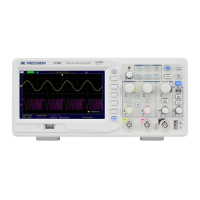
Do you have a question about the BK Precision 2190E and is the answer not in the manual?
| Model | 2190E |
|---|---|
| Category | Test Equipment |
| Bandwidth | 100 MHz |
| Channels | 2 |
| Sampling Rate | 1 GSa/s |
| Display Resolution | 800 x 480 pixels |
| Vertical Sensitivity | 2 mV/div to 10 V/div |
| Time Base Range | 5 ns/div to 50 s/div |
| Trigger Modes | Edge, Pulse, Video, Slope, Alternate |
| Math Functions | +, -, *, /, FFT |
| Power Supply | 100 - 240 VAC, 50/60 Hz |
| Type | Digital Oscilloscope |
| Display | 7 inch color display |
| Input Impedance | 1 MΩ ± 2% |
| Interface | USB |
| Connectivity | USB |
Defines safety category ratings (I, II, III, IV) based on electrical energy and voltage impulses.
Overview of oscilloscope features and details of package contents.
Introduction to the front panel controls and functions of the DSO.
Identifies and describes the connectors and features on the back panel.
Details the various elements of the oscilloscope's user interface and their functions.
Powering the oscilloscope and performing initial checks for readiness.
Procedures for self-tests, calibration, and checking firmware versions.
Setting probe attenuation and performing manual compensation for accurate measurements.
Description of menus, control buttons, and input/output connectors.
Explanation of the Auto Setup function for automatically displaying input signals.
Instructions on using vertical position and Volts/div knobs for waveform adjustment.
Overview of math operations and using FFT for frequency domain analysis.
Magnifying FFT spectrum and using cursors for measurements.
Choosing waveform source, saving, and recalling reference waveforms.
Description of horizontal controls, knobs, and their functions.
Adjusting horizontal settings including position, time, scan mode, and window zone.
Using trigger controls, selecting sources, and understanding trigger types.
Configuring trigger modes, coupling, and holdoff for stable waveform acquisition.
Setting up Pulse, Video, and Slope triggers for specific signal events.
Explanation of Acquisition modes: Sampling, Peak Detect, Average, and sampling details.
Details on Equivalent Time Sampling, Real Time Sampling, RUN/STOP, and SINGLE buttons.
Controlling Time Base and understanding Time Domain Aliasing effects.
Configuring waveform display types, persistence, intensity, and brightness.
Configuring display format, screen color, grids, and menu display time.
Setting screen skin and using X-Y format for phase analysis.
Making measurements using scale estimations and cursor tools.
Using manual, track, and auto cursor modes for waveform measurements.
Performing automatic measurements using recorded data points for enhanced accuracy.
Selecting input source and type for voltage measurements.
Selecting input source and type for time measurements.
Selecting delay parameters and accessing all measurement options.
Detailed descriptions of various voltage and time measurement types available.
Navigating SAVE/RECALL screen and managing files/folders.
Saving and recalling oscilloscope setups to internal memory or USB.
Saving current oscilloscope setup configurations to internal memory.
Saving oscilloscope setup configurations to a USB flash drive.
Restoring the oscilloscope to its factory default settings.
Saving waveforms to internal memory and USB flash drive.
Saving screen images (screenshots) to a USB flash drive.
Saving waveform data in CSV format to a USB flash drive.
Configuring system status, sound, counter, and display language.
Procedures for self-calibration and running self-test programs.
Updating the oscilloscope's firmware using a USB flash drive.
Using Pass/Fail function and configuring mask settings for testing.
Step-by-step guide to performing a Pass/Fail test with mask settings.
Recording input waveforms and playing back recorded or saved waveforms.
Enabling gap-free waveform recording in SCAN MODE.
Configuring the oscilloscope for network communication via LAN.
Accessing help and using education mode for learning.
Quickly displaying signals and taking simple measurements with auto setup.
Measuring the amplitude of a signal using cursors.
Setting up trigger level and slope to capture a single event accurately.
Investigating noisy signals to reveal details and reduce noise using Peak Detect and Average.
Using video trigger to obtain a stable display of video circuits.
Viewing impedance changes by displaying input vs. output signals in XY format.
Using math function to analyze differential signals and identify signal quality issues.
Controlling oscilloscope via PC software or SCPI commands through USB/LAN.
Explanation of common message prompts displayed by the oscilloscope.
Guides for resolving common issues like dark screen, no signal, or unstable display.
Specifications for oscilloscope inputs, impedance, voltage, sensitivity, and bandwidth.
Specs for DC accuracy, math functions, and trigger system parameters.
Specs for X-Y mode, frequency counter, Auto Set, and Save/Recall.
Specs for measurement system (32 types) and cursor modes.
General specs including display type, resolution, contrast, and waveform display modes.
Specs for operating temperature, humidity, altitude, power, dimensions, and weight.